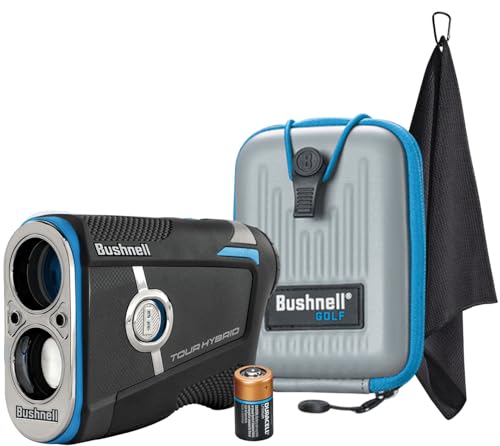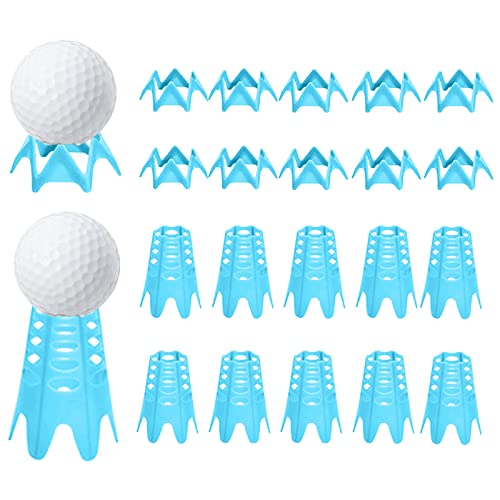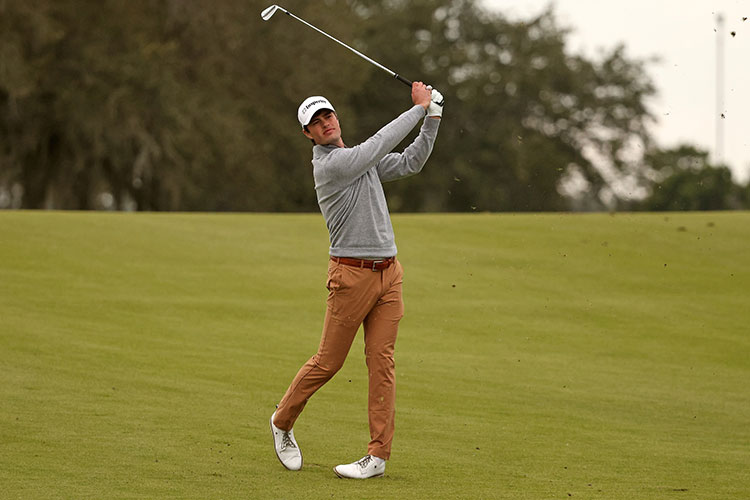To fix a slice in golf, adjust the grip and focus on your swing path. Are you struggling with a slice in your golf game?
Don’t worry, we’ve got you covered. Slicing can be a frustrating issue for many golfers, but with a few adjustments, you’ll be on your way to hitting straighter shots in no time. We’ll discuss some simple tips to fix a slice in golf.
By properly adjusting your grip and paying attention to your swing path, you can eliminate that frustrating curve and start hitting the ball straighter than ever before. So let’s dive in and improve your game by fixing that slice!
Understanding Your Golf Slice
Golf is a game of precision and finesse, and there’s nothing more frustrating than when your shots go awry. One of the most common issues that golfers face is the dreaded slice. If you find yourself consistently sending the ball off to the right (for right-handed players) or to the left (for left-handed players), then it’s likely that you’re dealing with a slice. Understanding what a slice is and how it affects your game is the first step towards fixing this problem and improving your performance on the course.
Defining What A Slice Is In Golf
A golf slice refers to a shot that curves excessively from left to right (for right-handed players) or from right to left (for left-handed players). This unwanted spin occurs when the clubface is open at impact, causing the ball to spin sideways in the air. As a result, the ball ends up veering off in the opposite direction, missing your intended target.
Common Misconceptions About Slicing The Ball
There are some misconceptions about the causes of a slice that can lead golfers down the wrong path when trying to fix it. One common myth is that a slice is caused solely by an outside-to-inside swing path. While it’s true that an improper swing path can contribute to a slice, it’s not the sole factor. In fact, the slice is primarily caused by an open clubface at impact. Another misconception is that a slice can be cured simply by adjusting your grip. While grip adjustments can certainly help, they won’t fix the problem entirely if the root cause is not addressed.
The Impact Of A Slice On Your Game
A slice can have a significant impact on your game, both in terms of accuracy and distance. When you consistently slice the ball, it becomes difficult to control where your shots will end up. This lack of accuracy can lead to frequent visits to the rough, hazards, or even out of bounds, resulting in penalty strokes and a higher score. Additionally, a slice robs you of distance. The side spin on the ball reduces its forward momentum, causing it to travel a shorter distance than intended. This can leave you with longer approach shots and more difficult scoring opportunities.
Diagnosing The Cause Of Your Slice
Are you tired of struggling with a slice on the golf course? Diagnosing the cause of your slice is the first step towards finding a solution. By understanding the factors that contribute to a slice, you can make the necessary adjustments to improve your swing and enjoy better results on the fairway. In this section, we will explore the grip, stance and alignment errors, swing path and plane issues, as well as equipment factors that may all play a role in causing your slice. Let’s dive in and uncover the root of the problem.
A proper grip is fundamental in achieving a consistent and accurate swing. When it comes to slicing, an incorrect grip can be a significant contributing factor. One common mistake is having a weak grip, where both hands rotate too much to the left for a right-handed golfer. This leads to an open clubface at impact, causing the ball to spin leftwards, resulting in a slice. To fix this, ensure your grip is firm but not overly tight, with both hands working together to square the clubface at impact.
Alongside grip, your stance and alignment also have a significant influence on the outcome of your shot. If your feet and body are misaligned, it can cause your swing path to be outside-in, which promotes a slice. To rectify this, align your feet, hips, and shoulders parallel to the target line, ensuring they point in the right direction. Also, pay attention to your weight distribution, with a slight bias towards the front foot for more control and forward momentum.
The path and plane of your swing have a direct impact on the direction and shape of your shot. A swing with an over-the-top motion, where the club comes down steeply from outside the target line, often results in a slice. Practice a more inside-out swing path by initiating the downswing with your lower body and keeping your arms and hands in sync. Additionally, avoid a flat swing plane, as it can cause the clubface to open at impact, leading to a slice. Focus on maintaining an upright posture and a consistent arc throughout your swing.
Aside from the technical aspects of your swing, equipment factors can also contribute to slicing. If you are using the wrong type of golf club or a driver with a shaft that is too flexible, it can exacerbate your slice. Consider getting a club fitting session to ensure your clubs match your swing characteristics. Moreover, inspect your clubs for any signs of wear or damage, as this can affect your ball flight. A well-maintained and properly fitted set of clubs can greatly reduce your chances of slicing.
Determining what causes your slice is crucial in developing a lasting solution. By addressing grip, stance, alignment, swing path, and equipment factors, you can work towards eliminating your slice and enjoying a more enjoyable and successful round of golf. Now that we have identified the potential culprits, let’s move on to the next step – correcting your slice with effective solutions.
How To Fix A Slice In Golf Correctly
Are you tired of your golf shots ending up in the rough or even worse, out of bounds? The dreaded slice can be a frustrating problem for many golfers. Luckily, there are effective techniques to fix a slice and improve your game. In this article, we will delve into three crucial aspects of fixing a slice in golf: adjusting your grip, modifying your stance, and practicing specific drills to improve your swing path and plane.
Adjusting Your Grip For Better Clubface Control
A proper grip can make a world of difference in controlling the clubface and fixing a slice. Follow these steps to achieve a correct grip:
- Start by placing the club handle diagonally across the fingers of your left hand (for right-handed players). The grip should be primarily in the fingers, not the palm.
- Wrap your fingers around the club and create a “V” shape between your thumb and index finger that points towards your right shoulder.
- Now, place your right hand (again, for right-handed players) underneath your left hand, with the pinky finger resting on the knuckles of your left hand. The “V” shape between your thumb and index finger should point towards your right shoulder.
- Make sure your grip pressure is firm but not overly tight. A relaxed grip allows for better control and flexibility in your swing.
By adjusting your grip to promote a neutral clubface position, you will have a more consistent grip that can help eliminate your slice.
Stance Modifications To Promote Proper Alignment
Your stance plays a crucial role in fixing a slice as it affects your alignment and swing path. Follow these tips to modify your stance:
- Position your feet shoulder-width apart.
- Assume a slightly open stance, with your left foot (for right-handed players) slightly flared outwards. This adjustment helps to encourage an inside-to-out swing path.
- Align your clubface with your target and ensure your body is parallel to the target line.
- Distribute your bodyweight evenly between your feet, with a slight favor towards your right side (for right-handed players).
By modifying your stance and achieving proper alignment, you are setting yourself up for a more successful and consistent swing.
Drills To Improve Swing Path And Plane
Practicing specific drills can help you develop a feel for the correct swing path and plane, leading to a more accurate ball flight and straighter shots. Here are a few drills to consider:
| Drill | Description |
|---|---|
| Alignment rod drill | Place an alignment rod or club shaft on the ground, parallel to your target line. Practice swinging the club along the path of the rod, ensuring the club stays inside the rod during the downswing. |
| Towel under armpits drill | Place a towel under both armpits and swing the club without dropping it. This drill promotes a proper swing plane and prevents an excessive “over-the-top” motion. |
| Inside-to-outside swing drill | Imagine swinging the club along a path that starts from the inside of the target line and finishes outside the target line. This drill helps correct an outside-to-inside swing path. |
By incorporating these drills into your practice sessions, you can gradually improve your swing path and plane, ultimately eliminating your slice and hitting more accurate shots.
Practice Techniques For Eliminating A Slice
Looking for effective techniques to fix a slice in golf? Discover proven practice methods to eliminate that pesky slice and improve your game. From grip adjustments to correct body alignment, master the skills needed to hit straight, consistent shots.
Range Exercises For Consistent Swing Mechanics
When it comes to fixing a slice in golf, one of the most effective ways is to practice specific range exercises that focus on improving your swing mechanics. By dedicating time to these drills, you can correct the flaws in your swing and develop a more consistent ball flight. Below are some range exercises to help you eliminate that slice:
- Grip adjustment: Start by checking your grip. An improper grip can be a major contributor to a slice. Make sure your hands are positioned correctly on the club, with the V formed by your thumb and index finger pointing towards your right shoulder (for right-handed golfers).
- Alignment drills: Proper alignment is crucial for a straighter shot. To practice this, place alignment sticks or clubs on the ground, parallel to your target line. Use them as visual aids to ensure your feet, hips, and shoulders are lined up correctly.
- Swing plane exercises: A steep or flat swing plane can lead to a slice. Use a headcover or an alignment stick to create a pathway for your club to follow during your backswing and downswing. This will help you maintain a more consistent swing plane.
- Weight transfer drills: Proper weight transfer is essential for a powerful and accurate swing. Practice transferring your weight smoothly from your back foot to your front foot during the downswing. This will encourage a more inside-out swing path, reducing the chances of slicing the ball.
On-course Strategies To Combat Slicing Tendencies
While practicing on the range is essential, it’s equally important to transfer those improvements onto the golf course. Here are some on-course strategies to help you combat slicing tendencies:
- Club selection: Choose a club that minimizes your slice tendencies. For example, if you usually slice with your driver, try using a 3-wood or hybrid off the tee until you gain more confidence in controlling your ball flight.
- Aim for the left side: Aim your shots slightly left of your target if you tend to slice the ball. This compensates for the curve of your slice, allowing the ball to end up closer to your intended target.
- Visualize a draw: Instead of focusing on avoiding a slice, actively visualize hitting a draw. This subtle mental shift can help rewire your brain and promote the correct swing path to counteract your slice tendencies.
- Control your tempo: Slicing can often be a result of an overly aggressive swing. Focus on maintaining a smooth and controlled tempo throughout your entire swing, especially during the transition from backswing to downswing.
Mental Tips For Staying Focused On The Fixes
Fixing a slice requires both physical adjustments and mental focus. Here are some mental tips to help you stay focused on the fixes:
- Positive self-talk: Instead of dwelling on past slices, use positive self-talk to reinforce your new swing improvements. Remind yourself of the adjustments you have made and the progress you are making towards eliminating your slice.
- Stay present: Avoid getting caught up in the outcome of each shot. Instead, focus on the process and the specific changes you have made to your swing mechanics. This will keep your mind engaged in the present moment and prevent distractions from sabotaging your progress.
- Practice visualization: Take a moment before each shot to visualize your desired ball flight. Imagine the ball curving smoothly in the opposite direction of your slice. This mental imagery can help reinforce the correct swing path and increase your chances of success.
- Patient persistence: Fixing a slice takes time and persistence. Be patient with yourself and celebrate small victories along the way. Rome wasn’t built in a day, and neither is a consistent, accurate golf swing. By staying committed to the process, you’ll eventually overcome that slice and enjoy more enjoyable rounds on the golf course.
Advancing Beyond The Slice
Learn how to fix a slice in golf with our comprehensive guide. Improve your swing and accuracy to take your game to the next level.
Introduction: Advancing Beyond The Slice
If you’ve struggled with a slice in your golf game, you know how frustrating it can be. The slice can wreak havoc on your accuracy and distance, causing your shots to veer off course and potentially ruining a good round. However, with the right techniques and practice, you can conquer the slice and take your game to the next level. In this section, we will explore how to monitor improvements in your swing, when to seek professional coaching, and how to incorporate technology for swing analysis.
How To Monitor Improvements In Your Swing
As you work on fixing your slice, it’s essential to monitor your progress and ensure you’re on the right track. Here are some effective ways to track improvements in your swing:
- Video Analysis: Record your swing from different angles using a smartphone or camera. Compare your current swing to earlier recordings to identify any changes or improvements.
- Shot Dispersion: Pay attention to the direction and shape of your shots during practice sessions. Notice if your ball flight becomes straighter and more consistent over time.
- Distance Control: Measure your distance with each club and note any changes. Improved technique and reduced slice can lead to better distance control.
- Accuracy: Keep track of how many fairways and greens in regulation you hit during rounds. As you fix your slice, your accuracy should improve, resulting in more successful shots.
When To Seek Professional Coaching
While self-improvement is important, there may come a point where seeking professional coaching can greatly benefit your progress. Consider the following situations when deciding whether to seek professional guidance:
- Stagnation: If you’ve been practicing consistently but haven’t seen significant improvements, a professional instructor can identify flaws in your technique and suggest appropriate adjustments.
- Complex Swing Issues: The slice might be just the tip of the iceberg. If you’re dealing with multiple swing issues or struggling to diagnose the root cause, a coach can provide invaluable insight.
- Mental Blocks: Overcoming the slice is not only about physical technique but also about mental confidence. A professional coach can help you develop strategies to overcome mental blocks and improve your overall game.
- Accelerated Progress: If you’re looking to expedite your improvement, a coach can provide personalized instruction, drills, and guidance to help you fix your slice more efficiently.
Incorporating Technology For Swing Analysis
Advancements in technology have made swing analysis more accessible and accurate than ever before. Here are some ways you can leverage technology to analyze and improve your swing:
- Launch Monitors: Utilize launch monitor devices that measure key swing metrics such as clubhead speed, ball spin, and launch angle. These devices provide objective data to assess your progress.
- Swing Apps: Numerous mobile apps offer swing analysis features, allowing you to record and analyze your swing using your phone. Some apps even provide visual overlays and comparison tools for better feedback.
- Virtual Coaching: Participate in online coaching sessions or subscribe to virtual coaching platforms that offer personalized swing analysis and feedback remotely.
- Simulators: Practice on golf simulators that provide detailed swing analytics. These simulators recreate realistic golfing environments and help you work on your swing mechanics.
Frequently Asked Questions For How To Fix A Slice In Golf
How Do You Get Rid Of A Slice In Golf?
To get rid of a slice in golf, focus on improving your grip, stance, and alignment. Keep your grip relaxed and your wrists firm. Align your feet, hips, and shoulders parallel to the target line. Swing with a square clubface and a slight inside-out path.
Practice consistently to build muscle memory and develop a straighter shot.
How Do You Fix A Slice In 5 Minutes?
To fix a slice in 5 minutes, practice correcting your grip, align your body towards the target, and swing from inside to outside to promote a straighter ball flight. Use drills like the towel-under-the-arm or glove-under-the-armpit technique to help maintain a proper swing path.
How Do You Grip A Golf Club To Fix A Slice?
To fix a slice, grip the golf club firmly but not too tight. Position your hands so that the V between your thumb and index finger points towards your right shoulder. This helps guarantee a square clubface at impact and reduces the chance of slicing the ball.
How Do You Compensate For A Slice In Golf?
To compensate for a slice in golf, you can try adjusting your grip, stance, and clubface. Swing with a square clubface, focus on an inside-out swing path, and practice with a golf professional to improve your technique. Proper alignment and regular practice can help you fix a slice and improve your golf game.
Conclusion
To sum up, fixing a slice in golf requires a combination of understanding the root causes and employing the right techniques. By focusing on your grip, alignment, and swing path, you can gradually rectify this issue. Consistency and practice are key to improving your game.
Remember to stay patient and persistent, as fixing a slice takes time and dedication. With dedication and the right approach, you’ll be on your way to straighter and more accurate shots in no time. Keep practicing and enjoy the game!





